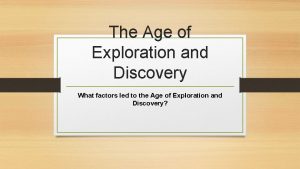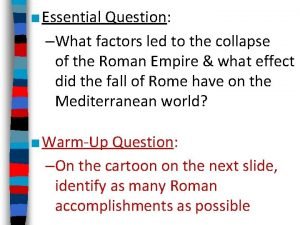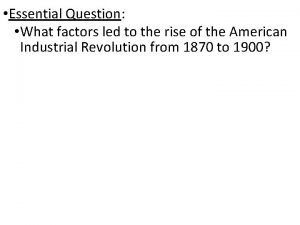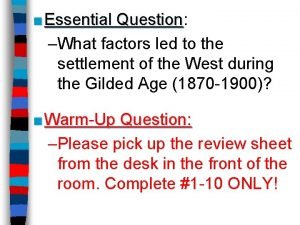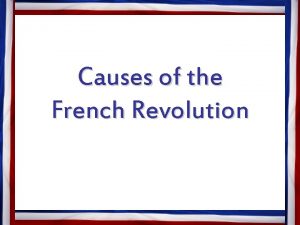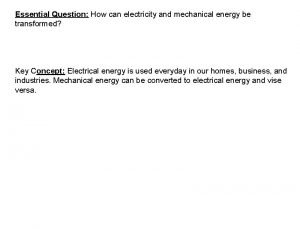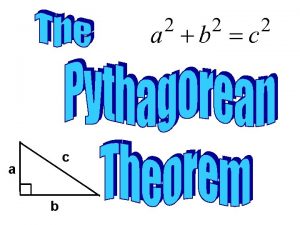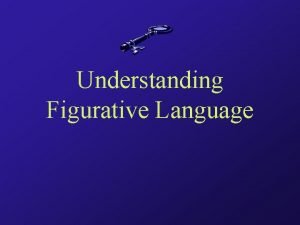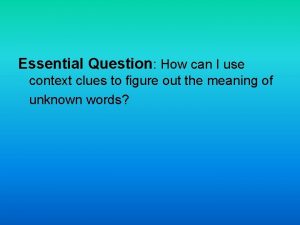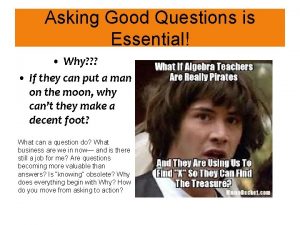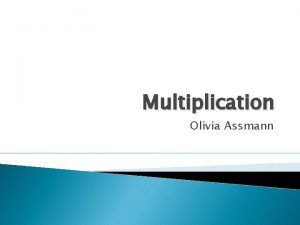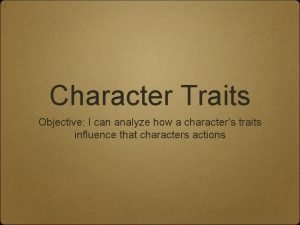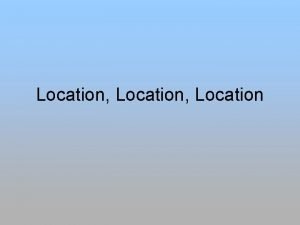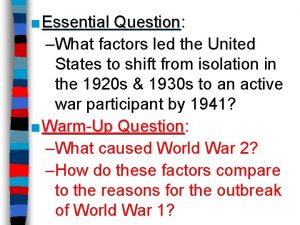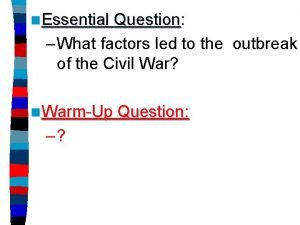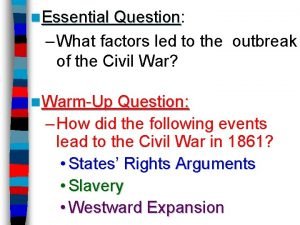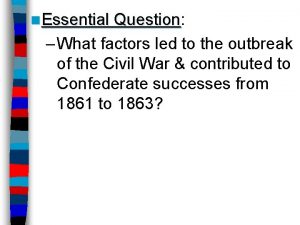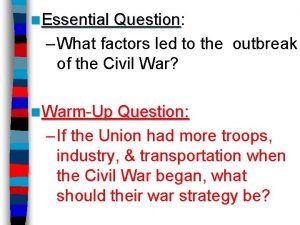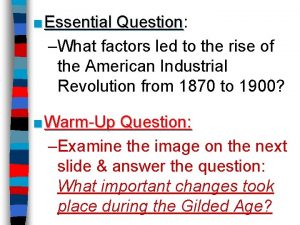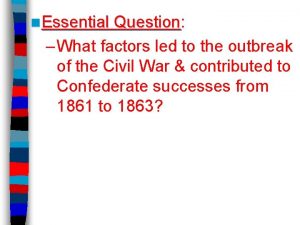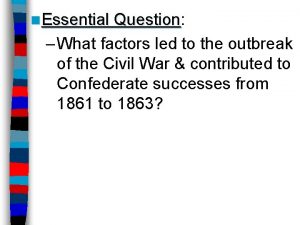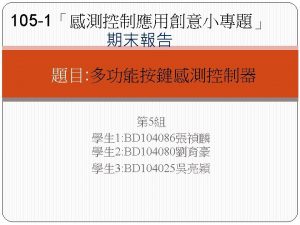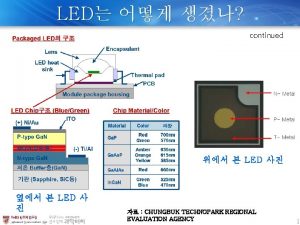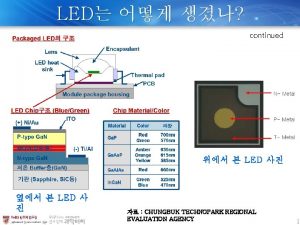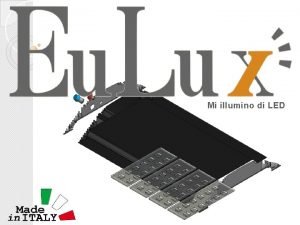Essential Question Question What factors led the United






























































- Slides: 62

■ Essential Question: Question –What factors led the United States to shift from isolation in the 1920 s & 1930 s to an active war participant by 1941?

American Isolationism & Foreign Policy in the 1920 s & 1930 s

Foreign Policy in the 1920 s & 1930 s ■ After WWI, the U. S. assumed a selective isolationist foreign policy –Americans wanted to maintain the economic boom of the 1920 s & were desperate for an answer to the depression in the 1930 s –But, the U. S. did play an active role in attempts at international disarmament & economic stability

In 1924, Hoover negotiated a reduction in The U. S. Foreign Debt Commission Foreign Policy: Economic Policy German debt, anportion extended canceled a large of time theseperiod debts, to but ■insisted In the 1920 s, most divisive repay debts, &some U. S. the loans to help Germany that of the money be repaid make payments issue to France & England international was war debts: The Dawes Plan helped stabilize the German –European nations owed U. S. economy, allowed Germany to repay the $10 billion; Attempts to reclaim Allies, and helped France & England repay these debts led. United to anti-American their debts to the States sentiment in Europe –When Germany could not repay $33 billion in reparations, the U. S. negotiated the Dawes Plan

European Debts to. Hyper-inflation the U. S. in Germany by 1923

Foreign Policy: Economic Policy ■ But the Great Depression made post-war recovery in Europe difficult in the 1930 s: –The Hawley-Smoot Tariff in 1930 limited European attempts to sell their goods in the U. S. –The U. S. was unable to provide loans, leaving Germany unable to repay reparations & Europe unable to repay its war debts

The USA, England, Japan, Italy, & France Foreign Policy: International Peace But, The neither Nine-Power the Nine. Treaty or Four-Power reaffirmed Acts England, USA, Japan, France signed the Foursigned the Five-Power Treaty & agreed to limit had provisions the Chinese to enforce Open-Door these Policy agreements ■ The USA never joined the League Power Treaty agreeing to collective security construction of battleships & aircraft carriers of Nations, but did play a role in attempts to avoid future wars: –At the Washington Disarmament Conference in 1921, world leaders agreed to disarmament, free trade, & collective security –In 1928, almost every nation, including the USA, signed the Kellogg-Briand Pact, Pact renouncing war as a tool of foreign policy

Foreign Policy: International Peace ■ These agreements did not last: –Japan needed raw materials to continue its industrial expansion –Japan began to create an Asian empire by attacking Manchuria in 1931 & China in 1937 –In both occasions, the League of Nations reprimanded Japan but chose no punitive measures

Totalitarian Regimes: Hideki Tojo & Emperor Hirohito

In 1937, Japanese pilots bombed the USS Panay, Invades Manchuria a U. S. gunboat stationed in China, killing 3 Americans. The U. S. accepted Japan's apology & promise against future attacks Unlike the USS Maine or Lusitania, few Americans called for war against Japan

Totalitarian Regimes: Benito Mussolini

Totalitarian Regimes: Hitler


The Munich Pact “Peace in our time”

Rome-Berlin-Tokyo Axis

Foreign Policy: International Peace ■ In the 1930 s, FDR & Congress were too preoccupied with the Great Depression to adequately plan for new world conflicts involving totalitarian dictators ■ The rising threat of war in Europe & Asia strengthened Americans’ desire to avoid involvement in another world war

Foreign Policy: Citizen Attitudes ■ In the 1920 s & 1930 s, most Americans wanted to avoid another “meaningless war” –Munitions makers & bankers were labeled “merchants of death” & were blamed for. Road to Historian Walter Millis’ America’s War. American blamed Wilson & British propaganda involvement in WWI for “duping” the U. S. into WWI –Passivism swept across college campuses; Students staged “walk-outs” & anti-war rallies

Veterans of FUTURE Wars

The “Lost Generation” All Quiet on the Western Front portrayed WWI as brutal

The Neutrality Acts ■ Congress passed 3 neutrality acts to avoid future wars The Neutrality Act of 1935 banned arms sales to nations at war & warned citizens not to sail on belligerent ships The Neutrality Act of 1936 banned loans to any warring nation The Neutrality Act of 1937 made the 1935 & 1936 acts permanent

■ Essential Question: Question –How did the Japanese attack on Pearl Harbor alter the course of World War 2?

The Road Towards American Intervention

From Neutrality to Undeclared War ■ As Europe headed toward war, FDR openly expressed his favor for intervention & took steps to ready the U. S. for war –In 1937, FDR unsuccessfully tried to convince world leaders to “quarantine the aggressors” –Peacetime draft



From Neutrality to Undeclared War “The destroyer-for-bases deal is the most ■important When WW 2 began in“merchants 1939, of Still attempting to avoid more action in the reinforcement of death” in the banking our national defense thataindustry has been&taken Congress imposed cash carry since the Louisiana Purchase” policy to aid the Allies: —FDR –The U. S. would trade with the FDR responded with all-out aid to Which eased the rigid restrictions of the Allies but would not offer loans the Allies. Acts but of did 1935 -1937 not call fortowar Neutrality allow –The not deliver the U. S. US to would aid England & France American products to Europe ■ In addition, FDR traded 50 old Still destroyers attempting towith avoid. England losing American for 8 lives at sea by German submarines naval bases in Western Europe

From Neutrality to Undeclared War “The future of western Isolationistscivilization Interventionists is being decided Groups like the ■ Were appalled by the■battlefield upon of Europe” Committee to —CDAAA chair, William this departure from Allen White Defend America by neutrality & FDR’s Aiding the Allies involvement of the called for unlimited U. S. in foreign war aid to England ■ Their “fortress of ■ They argued that America” idea St. Louis that Dispatch headline: the events in argued “Dictator Roosevelt Europe did impact Germany was not Commits Act of War” a threat to the U. S. the security of U. S.

From Neutrality to Undeclared War ■ By 1940, “interventionists” had the majority of American public sentiment on their side: –in 1940, Congress appropriated $10 billion for preparedness –FDR called for America’s first ever peacetime draft –In the election of 1940, FDR was overwhelmingly elected for an unprecedented 3 rd term

From Neutrality to Undeclared War ■ By 1940, England remained the only active opposition to Hitler but was running out of money ■ FDR called for a Lend-Lease Act: Act –U. S. can sell or lend war supplies to Allied nations –Congress put $7 billion to allow England full access to U. S. arms

Lend-Lease Supply Routes

From Neutrality to Undeclared War ■ England desperately needed help escorting U. S. -made supplies through the u-boat infested Atlantic –FDR allowed for U. S. patrols in the western half of the Atlantic –German attacks on U. S. ships in 1941 led to an undeclared naval war between USA & Germany

From Neutrality to Undeclared War ■ In 1941, FDR & Churchill met to secretly draft the Atlantic Charter: Charter –The U. S. & Britain discussed a military strategy if the USA were to enter the war –They discussed post-war goals of free trade & disarmament ■ In 1941, Germany broke the Nazi. Soviet Pact & invaded Russia


From Neutrality to Undeclared War ■ FDR brought U. S. to the brink of war & opened himself to criticism: –In Sept 1941, polls showed 80% of Americans supported remaining neutral in WW 2 –FDR had to wait for the Axis to make a decisive move…which Japan delivered on Dec 7, 1941

Pearl Harbor

Showdown in the Pacific ■ Japan took full advantage of the European war to expand in Asia: –Attacked coastal China –Seized French & Dutch colonies in East Indies & Indochina –Signed the Tripartite Pact with Germany & Italy in 1940 ■ FDR retaliated against Japan with fuel, iron, & oil sanctions

The Greater East Asia-Prosperity Company Rich in Tin, Oil, Rubber

Showdown in the Pacific ■ In 1941, the U. S. & Japan were unable diplomatically resolve This wastoreally a stall tactic intended to hide Japanese military preparations their differences, so the USA: for an the attack on. Japan Pearlwanted Harboran end U. S. wanted –Froze all Japanese assets USA Japanese removed to sanctions & in a free from China handtoto. Japan China –Banned all oil sales ■ Hideki Tojo sent an envoy to negotiate for a resolution…but secretly ordered an attack on the U. S. naval base at Pearl Harbor

On Dec 7, 1941, the U. S. naval fleet in the Pacific was crippled by the attack; 8 battleships were sunk & 2, 400 Americans were killed

Showdown in the Pacific ■ After Pearl Harbor: –Congress declared war against Japan on Dec 8, 1941 –Italy & Germany declared war on the U. S. on Dec 11, 1941 ■ American public opinion The U. S. now was faced now a possible war… fully behind the war 2 -ocean effort to defeat the fascist threat in Europe to …but Germany was&still seen against as the primary danger seek revenge Japan

■ Essential Question: Question –What role did the U. S. play in winning the wars in Europe & the Pacific?

When the U. S. entered WW 2 in late 1941, Japan dominated Germany controlled the western half of almost all ofvictory Europeseemed remote the Pacific Ocean Germany pressed into Russia Axis armies controlled Northern Africa & threatened But…over the next 2 years, the U. S. & the Allies Suezto. Canal began win the wars in Europe & the Pacific

Europe 1941 -1943 The U. S. wanted to attack across Nazi-controlled France by 1943 The USSR “freed” Poland, England. Hungary, wanted to. Romania attack Italy from In 1942, troops To U. S. -Anglo win the European In 1943, Africa the Soviet armycampaign, won. Italian at Stalingrad; Northern in began the 2 campaign different Germany again on was the offensive 1942 was never & Stalin ANGRY plans were proposed

The Allies began to win the Battle of the Atlantic in 1941 with Lend-Lease aid, but took control in 1943 with America’s entry into the war

Tehran Conference, 1943 By agreeing to “Operation Overlord” (D In-Day), 1943, the Churchill, Stalin in FDR■proposed a. FDR, future United dominated Allies would. Nations divide themet Axis by “ 4 Tehran, policemen” (USA, Britain, & USSR) Iran foracross the first offronts three military two. China, with power to “deal immediately with any sudden wartime conferences: emergency which requires action” – The USA, Britain, USSR coordinated their war strategy – FDR & Churchill finally committed to Stalin’s demands to open a western front (D-Day) – Discussed plans to create a “general internat’l organization” to promote “peace & security” (UN)

Allied ingenuity helped win the war: U. S. Hedgerows in Normandy soldiers were trained to problem-solve rather than wait for orders

Yalta Conference in February 1945 ■ The. To“Big 3” met Yalta to & recognize theat independence discuss post-war given sovereignty of nations. Europe in Eastern Europe the eminent defeat of Germany: –Stalin refused to give up Eastern Europe but he did agree to “selfdetermination” –Stalin agreed to send Soviet troops to the Pacific after the German surrender if the USSR could keep Manchuria

Soon after the Yalta Conference in Feb 1945, FDR died…and Harry Truman became president

In late April 1945, the Allies broke through the Eastern & Western Fronts forcing both Italy & Germany to surrender

Europe 1944 -1945 1941 -1943

“Island-hopping” allowed the. Tokyo Allies on to win The Doolittle Raid on strategic islands without April 18, 1942 wasinvesting a morale precious boost time, resources, & American lives U. S. victory at Midway in 1942 gave the Allies naval supremacy

The Japanese refused to play according to the Geneva Convention “rules” of war

The German surrender in May 1945, allowed the U. S. to turn its full attention towards Japan Victories at Saipan in 1944 & Iwo Jima & Okinawa in 1945 allowed for bombings on Japan

The Decision to Drop the A-Bomb ■ With no definitive end it sight, how would the Allies defeat Japan? –The U. S. military favored a fullscale invasion of Tokyo by 1946 –The Japanese refused to surrender & were arming civilians for an Allied invasion –At the Potsdam Conference in July 1945, Truman gave the order to use the atomic bomb

■ Essential Question: Question –What role did the U. S. play in winning the wars in Europe & the Pacific?

Enrico Fermi at the University of Chicago (physicist who developed the nuclear reactor)

Triumph & Tragedy in the Pacific ■ In August 1945, the USA forced Japan to surrender by dropping 2 atomic bombs ■ Effect of the atomic bomb: –Saved hundreds of thousands of American (& Japanese) lives –Revenge for Pearl Harbor –Showed the USSR that the USA had the ultimate weapon (began the Cold War nuclear arms race)

Nagasaki Hiroshima


WW 2 Timeline (Allies, Axis, USSR)

Its Finally Over!

Conclusions ■ WW 2 was the largest & deadliest war in history & changed the U. S. –Wartime industry ended the Great Depression, expanded the size of the federal gov’t, & ushered in affluent decade –The USA emerged as a world superpower, developed a nuclear arsenal, & engaged a Cold War against the USSR
 Characteristics of lipids
Characteristics of lipids What factors led to the age of exploration
What factors led to the age of exploration What factors led to the decline of the roman republic
What factors led to the decline of the roman republic What factors led to
What factors led to What factors led to
What factors led to Cattle ranching
Cattle ranching What factors led to the french revolution
What factors led to the french revolution Costa question
Costa question Essential question for figurative language
Essential question for figurative language Pythagorean theorem essential questions
Pythagorean theorem essential questions Essential question generator
Essential question generator Essential question for pythagorean theorem
Essential question for pythagorean theorem Language
Language Individual vs. society
Individual vs. society Context clues essential questions
Context clues essential questions Cornell notes essential question
Cornell notes essential question What makes a question essential
What makes a question essential Essential questions for multiplication
Essential questions for multiplication Essential question gif
Essential question gif Essential question for character traits
Essential question for character traits The cornell way
The cornell way Short story essential questions
Short story essential questions Situation location
Situation location Abiotic factors
Abiotic factors Abiotic vs biotic factors
Abiotic vs biotic factors Aboitic environment
Aboitic environment Is a raspberry bush biotic or abiotic
Is a raspberry bush biotic or abiotic Location
Location Find the factors of 24
Find the factors of 24 Factors of 7
Factors of 7 Factors of 8-
Factors of 8- Hình ảnh bộ gõ cơ thể búng tay
Hình ảnh bộ gõ cơ thể búng tay Lp html
Lp html Bổ thể
Bổ thể Tỉ lệ cơ thể trẻ em
Tỉ lệ cơ thể trẻ em Chó sói
Chó sói Chụp tư thế worms-breton
Chụp tư thế worms-breton Chúa sống lại
Chúa sống lại Các môn thể thao bắt đầu bằng tiếng đua
Các môn thể thao bắt đầu bằng tiếng đua Thế nào là hệ số cao nhất
Thế nào là hệ số cao nhất Các châu lục và đại dương trên thế giới
Các châu lục và đại dương trên thế giới Công thức tính độ biến thiên đông lượng
Công thức tính độ biến thiên đông lượng Trời xanh đây là của chúng ta thể thơ
Trời xanh đây là của chúng ta thể thơ Mật thư tọa độ 5x5
Mật thư tọa độ 5x5 Làm thế nào để 102-1=99
Làm thế nào để 102-1=99 Phản ứng thế ankan
Phản ứng thế ankan Các châu lục và đại dương trên thế giới
Các châu lục và đại dương trên thế giới Thơ thất ngôn tứ tuyệt đường luật
Thơ thất ngôn tứ tuyệt đường luật Quá trình desamine hóa có thể tạo ra
Quá trình desamine hóa có thể tạo ra Một số thể thơ truyền thống
Một số thể thơ truyền thống Cái miệng nó xinh thế chỉ nói điều hay thôi
Cái miệng nó xinh thế chỉ nói điều hay thôi Vẽ hình chiếu vuông góc của vật thể sau
Vẽ hình chiếu vuông góc của vật thể sau Thế nào là sự mỏi cơ
Thế nào là sự mỏi cơ đặc điểm cơ thể của người tối cổ
đặc điểm cơ thể của người tối cổ V. c c
V. c c Vẽ hình chiếu đứng bằng cạnh của vật thể
Vẽ hình chiếu đứng bằng cạnh của vật thể Tia chieu sa te
Tia chieu sa te Thẻ vin
Thẻ vin đại từ thay thế
đại từ thay thế điện thế nghỉ
điện thế nghỉ Tư thế ngồi viết
Tư thế ngồi viết Diễn thế sinh thái là
Diễn thế sinh thái là Dạng đột biến một nhiễm là
Dạng đột biến một nhiễm là

